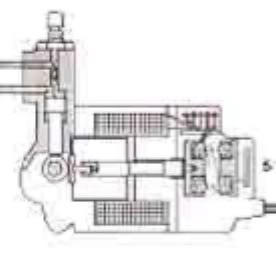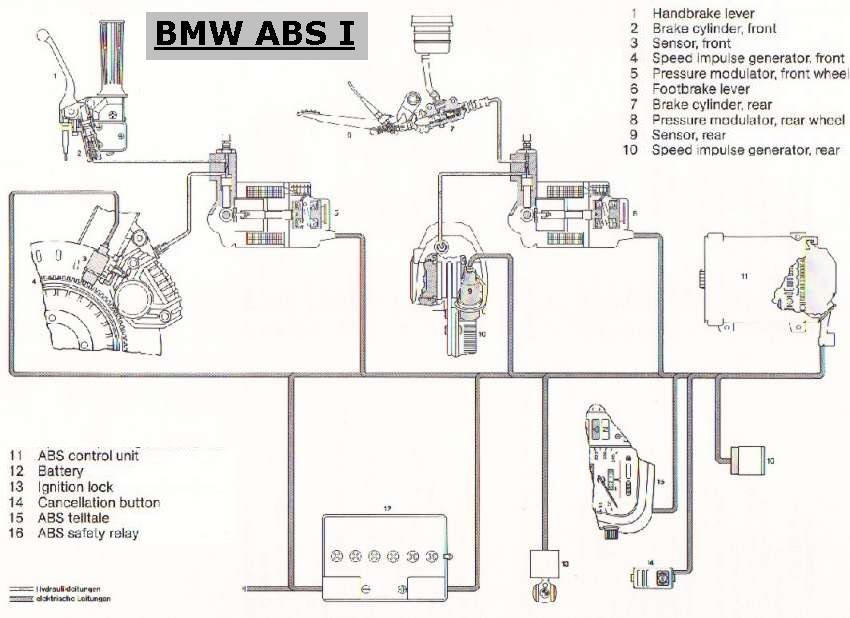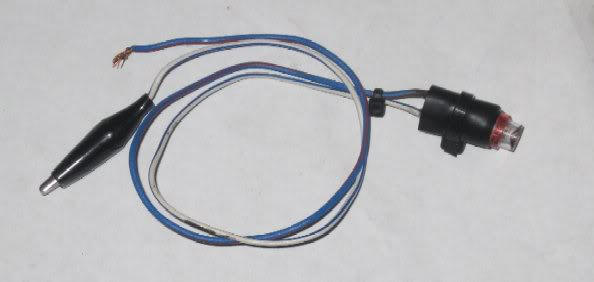© 2013 Drake Smith - Please do not
use or reproduce this elsewhere. Feel free to link to it
though.
ABS -
K75, K100, K1 & K1100
To skip the
description and go to reset and diagnose:
CLICK HERE
How an ABS
(Anti-lock Braking System) works: Very simply, when
the ABS control unit (a.k.a. ABS brain) senses that one of your
wheels is slowed to the point where it is about to stop moving
while the other wheel is moving it "modulates" the pressure in
the brake line. Modulating is relieving the pressure in the
brake system and then reapplying it. This allows the tire to be
"locked" (skidding) for only a very short period of time so that
it doesn't slide out from under the bike in the case of the
front wheel or swing around to the side in the case of the rear
wheel.
BMW ABS I & ABS II: BMW was
the first motorcycle manufacturer to build bikes with ABS. As a
result, the technology is rather crude by today's standards but
the important part is that it works and can help you avoid an
otherwise inevitable accident. The crudeness of these early ABS
systems is evidenced in the rather long cycle times for
modulation. When the ABS kicks the wheels will go "clunk,
clunk, clunk."
What is the value of ABS? ABS
keeps your front and/or rear wheels from locking up (skidding)
when the brakes are over-applied for the available traction.
Some common scenarios where ABS is useful:
- Changing traction situations: For example when you're
braking and you ride over some gravel or sand that you didn't
see or when you're braking on a wet road and travel over a metal
surface such as a manhole cover. In these situations an ABS
system will sense a lockup and release the brakes much more
quickly than most, if not all, riders could, thus reducing the
risk of the rider crashing.
- Emergency braking situations: For example when a car
pulls out in front of you unexpectedly or a deer leaps out into
the road ahead of you. In theory, a very skilled rider knows
where the threshold between maximum braking and locking up a
wheel is and can outbrake an ABS-equipped bike. This is true
for people like professional racers and people who practice
threshold braking frequently. However, in reality, most riders
cannot "outbrake" an ABS-equipped bike on a non-ABS bike. They
will either overbrake, locking up one or both wheels (and
potentially crash) or underbrake for fear of locking up a wheel
and their stopping distance will be longer than if they'd been
on an ABS-equipped bike. In an emergency braking situation, an
ABS system allows the rider to risk overbraking without locking
up one or both of the wheels, thus allowing him/her to stop
sooner and in a shorter distance (or at least scrub off more
speed before a collision) than on a non-ABS bike.
What does it feel like when the ABS kicks in? The
easiest way to find that out is to try it. Find a level clear
dry parking lot or section of roadway with no other traffic
around. Get the bike up to 25-30 mph and apply a lot of
pressure quickly to the rear brake. You'll feel the clunk,
clunk, clunk of the rear ABS kicking in. This really is a very
safe exercise and I recommend that everybody try this at least
once. That way, when it kicks in in real life, you won't be
surprised by it but will realize that it's your ABS kicking in
and not something failing on your bike. Try the front too if
you think you're up to it.
ABS System Components:
Front master cylinder and reservoir, rear master cylinder and
reservoir: These are the same as non-ABS master cylinders and
reservoirs and function identically.
Front and rear calipers: These function identically to
non-ABS calipers.
Front and rear ABS sensors: These are inductive sensors
that pulse as the teeth of the ABS rings go by them when the
bike is moving. The rates of the pulses from each sensor tell
the ABS brain how fast each wheel is turning, thus allowing it
to detect when a wheel is about to, or has, locked up and is
skidding.
Front and rear ABS modulators: On ABS I bikes, the front
ABS modulator is mounted above the rear of the left side peg
plate. (Except for the K1 where it is mounted inside the left
front of the fairing.) The rear modulator is mounted above the
rear of the right peg plate. The function of the modulators is
to let off and then re-apply braking pressure to keep their
respective wheels from remaining locked up. They are controlled
by the ABS brain.
ABS modulator cutaway diagram:

On ABS II bikes (model year 1994 and later K1100 models) both
ABS modulators are integrated together with the ABS brain into a
single unit under the seat. (The metal housing under the left
side of the seat marked FAG.)
ABS control unit (brain): This is a computer of sorts
that, based upon input from the front and rear ABS sensors,
determines if a wheel is about to, or has, locked up and
controls the modulators accordingly. On K75s and 2 valve K100s
the ABS brain is located under the roof of the tail cowl. On 4
valve ABS I K bikes the ABS brain is mounted under the seat
behind the battery. On an ABS II bike the ABS brain is
integrated with the modulators into a single unit as described
in the prior paragraph.
ABS System Schematic: (ABS
II is conceptually similar)

Flashing ABS warning lights and what they mean:
After the bike has started but before it's moved: The
ABS warning lights in your instrument cluster will flash until
the bike is under way. The reason for this is that upon startup
the ABS brain tests the sensors, modulators and it's own
internal functioning to make sure all components of the system
are fully operational. Since the ABS brain cannot test the
sensors until the bike is moving and it gets inductive pulses
from them it will remain in this test mode and the lights will
keep flashing until you ride off. Once it has verified that all
components are working as you initially ride off, the ABS
warning lights will go out if everything is OK. Your ABS is
working and ready to modulate either or both the front and rear
brakes should the need arise.
After the bike is moving: If the ABS warning lights
remain flashing after the bike is under way then this indicates
that the ABS is in fault mode. The lights will keep flashing to
remind you that you don't have ABS brakes. When the ABS brain
is in fault mode your brakes will keep working though - just as
normal non-ABS brakes would. If you press the ABS switch on the
dash then the ABS warning lights will go solid for several
minutes so they're less obnoxious and distracting but after that
several minutes have transpired the ABS warning lights will start
flashing again to remind you that your ABS is in fault mode and
not operational. Hit the ABS switch to make them go solid again
for another few minutes.
How do I "fix" a faulted ABS system?
ABS control units are somewhat sensitive to low battery voltages.
Many times that is the cause of an ABS fault and a simple reset
in all that's required to make the ABS system operational again.
Resetting the ABS: The first thing to try is resetting
the ABS to clear the fault. Open your seat and look for a blue
plastic cap on a three wire connector which is a diagnostic plug
for hooking up to a computer at the BMW dealer. If you don't
see the blue plastic cap then it may be lost. In that case look
for a black plastic connector under the seat that has three
wires and is not connected to anything.
Diagnostic plug cap:

Once you've located the diagnostic plug cap, remove the cap and
stick the stripped end of a piece of wire into the center
terminal of the diagnostic plug. Ground the other end somewhere
on the bike. For 93 and earlier K bikes a good place to ground
the other end of the wire is where the battery ground is bolted
to the left side of the transmission near the shift lever.
Once your wire is grounded, hold down the ABS switch and turn
the key all of the way clockwise to turn the bike on while
keeping the ABS switch depressed. (You don't need to start the
bike, just turn it on.) Count to thirty slowly. Then turn off
the bike. Hopefully the ABS fault is now cleared.
Remove the grounded wire from the diagnostic plug, replace the
diagnostic plug's protective cap and then go for a short ride.
If the ABS brain has been reset successfully then the ABS
warning lights should go out after the bike has moved several
feet.
Note that sometimes it can take several reset attempts for the
reset to take so try it a few times if the first reset doesn't
resolve your problem. (Hence the Voodoo nature of it.)
Failing or low battery: BMW ABS brains are sensitive to low
voltage so a faulting ABS brain may be a symptom that your
battery needs to be replaced. If you suspect that an old or
dying battery may be causing your ABS problems then remove
the battery and take it to your nearest auto parts store.
Ask them to "load test" the battery for you. They will do it
for free. (It gets you in their store to buy other stuff, helps
them test the condition of batteries they sold that are still
under warranty and, most importantly, it helps them sell
batteries.)
Reading ABS fault codes:
If the reset didn't take and your battery doesn't seem to be the
issue, then it is possible to use the diagnostic plug to "read"
the fault code from the ABS brain to determine what the ABS
thinks is wrong. This can be done using either a 12V LED bulb or
an analog voltmeter. (You can't use a normal incandescent bulb
to read fault codes due to the amount of current they require.)
The LED or voltmeter is used to count the dips in voltage at the
center terminal on the diagnostic plug.
Reading fault codes with a 12V LED: 12V LEDs are readily
available from Radio Shack and on Fleabay. Remove the blue
protective cap from the diagnostic plug. Connect the positive
terminal of the LED to the center hole of the diagnostic plug
and ground the other terminal of the LED. When you turn the
bike on (there's no need to start it) the LED should
illuminate. Count the number of times the LED flashes OFF to
determine the fault code. The ABS brain will keep cycling so if
you don't get the count the first time just wait a few seconds
and it will be repeated.
Since I play around with K bikes a lot and own several with ABS
I built myself a little pre-wired 12V LED-bulb for reading fault
codes. It has an alligator clip on the ground lead and a
stripped wire at the end of the positive lead:

Reading the fault code with an analog voltmeter: You
need to use an analog voltmeter (one with a needle) because
digital voltmeters don't react to the drops in voltage quickly
enough to count them. (Unless you've got a digital voltmeter
that costs more than your bike did. :D) Put the positive (red
wire) probe of your voltmeter into the center hole of the
diagnostic plug and ground the other (black wire) probe
somewhere on the bike. Count the number of dips in voltage
(needle drops to the left) to determine the fault code.
Fault codes and what is causing the ABS fault:
1 - Front modulator
2 - Rear modulator
3 - Front ABS sensor
4 - Rear ABS sensor
5 - Low battery
6 - ABS relay
7 - ABS control unit (brain)